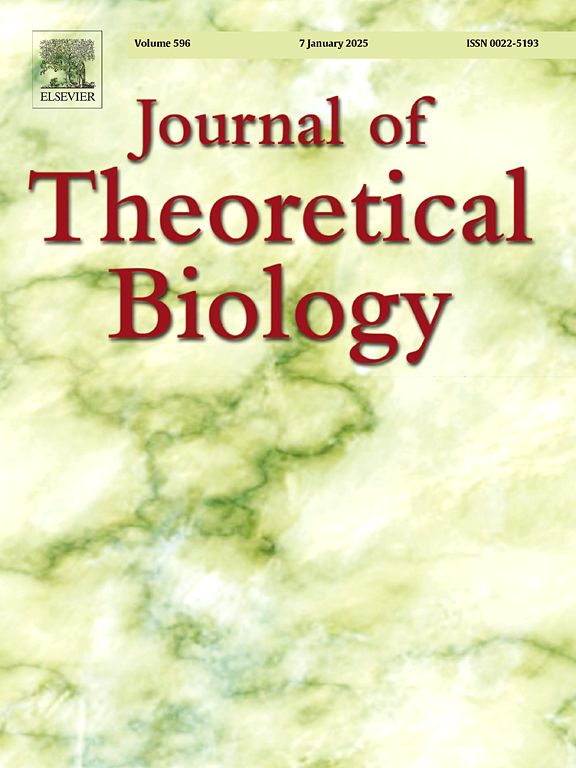Rankings of tuberculosis antibiotic treatment regimens are sensitive to spatial scale, detection limit, and initial host bacterial burden
IF 1.9
4区 数学
Q2 BIOLOGY
引用次数: 0
Abstract
Pulmonary infection after inhalation of Mycobacterium tuberculosis (Mtb) causes tuberculosis (TB). TB presents with lung granulomas − complex spheroidal structures composed of immune cells and bacteria. Granulomas often have centralized caseum (necrotic tissue) where mycobacteria are quarantined, complicating and prolonging multi-antibiotic regimens. Determining which antibiotic regimens are optimal for reducing treatment time and toxicity is a goal of recent TB eradication campaigns. Clinical trials are expensive and challenging, making it difficult to untangle which host-pathogen interactions drive heterogeneous infection and treatment outcomes observed both within and between hosts. To determine responses to antibiotic regimens, we simulate treatments in HostSim, our whole-host mechanistic, multi-scale computational model of Mtb-infection. HostSim tracks dynamics of pulmonary Mtb-infection over molecular, cellular, tissue, organ, and whole-host scales. We create a heterogenous virtual cohort, comprising distinct hosts, for virtual clinical trials. We represent drug treatments by newly-integrating pharmacokinetics / pharmacodynamics into HostSim, simulating treatment with commonly-prescribed TB antibiotic regimens (e.g., HRZE or BPaL). Our approach allows us to identify both (1) which hosts/granulomas improve with treatment, and (2) which mechanisms influence outcome heterogeneity. By tracking experimental and clinical measurements, we virtually recreate several drug rankings from literature. We find that many methods of ranking treatment efficacy are strongly influenced by the ‘definition of improvement’ used and, in some cases, the detection threshold of CFU. Our work suggests that a study’s reported optimal treatment may depend on its experimental design, including initial disease state and bacterial burden measures, possibly explaining seemingly-contradictory findings from prior studies.
结核病抗生素治疗方案的排名对空间尺度、检出限和初始宿主细菌负担敏感。
吸入结核分枝杆菌(Mtb)后的肺部感染导致结核病(TB)。结核病表现为肺肉芽肿——由免疫细胞和细菌组成的复杂球体结构。肉芽肿通常有集中的坏死组织(坏死组织),其中分枝杆菌被隔离,使多种抗生素治疗方案复杂化并延长。确定哪种抗生素方案对于缩短治疗时间和减少毒性是最佳的,这是最近结核病根除运动的一个目标。临床试验既昂贵又具有挑战性,这使得很难理清宿主-病原体相互作用驱动宿主内部和宿主之间的异质感染和治疗结果。为了确定对抗生素方案的反应,我们在HostSim中模拟治疗,HostSim是我们的全宿主机制,mtb感染的多尺度计算模型。HostSim在分子、细胞、组织、器官和整个宿主尺度上跟踪肺部mtb感染的动态。我们创建了一个异质的虚拟队列,包括不同的宿主,用于虚拟临床试验。我们通过将药代动力学/药效学新整合到HostSim中来代表药物治疗,模拟常用的结核病抗生素治疗方案(例如,HRZE或BPaL)。我们的方法使我们能够确定(1)哪些宿主/肉芽肿在治疗后得到改善,以及(2)哪些机制影响结果的异质性。通过跟踪实验和临床测量,我们从文献中重建了几种药物排名。我们发现,许多对治疗效果进行排名的方法都受到所使用的“改善定义”的强烈影响,在某些情况下,还受到CFU的检测阈值的影响。我们的工作表明,一项研究报告的最佳治疗可能取决于其实验设计,包括初始疾病状态和细菌负担测量,这可能解释了先前研究中看似矛盾的发现。
本文章由计算机程序翻译,如有差异,请以英文原文为准。
求助全文
约1分钟内获得全文
求助全文
来源期刊
CiteScore
4.20
自引率
5.00%
发文量
218
审稿时长
51 days
期刊介绍:
The Journal of Theoretical Biology is the leading forum for theoretical perspectives that give insight into biological processes. It covers a very wide range of topics and is of interest to biologists in many areas of research, including:
• Brain and Neuroscience
• Cancer Growth and Treatment
• Cell Biology
• Developmental Biology
• Ecology
• Evolution
• Immunology,
• Infectious and non-infectious Diseases,
• Mathematical, Computational, Biophysical and Statistical Modeling
• Microbiology, Molecular Biology, and Biochemistry
• Networks and Complex Systems
• Physiology
• Pharmacodynamics
• Animal Behavior and Game Theory
Acceptable papers are those that bear significant importance on the biology per se being presented, and not on the mathematical analysis. Papers that include some data or experimental material bearing on theory will be considered, including those that contain comparative study, statistical data analysis, mathematical proof, computer simulations, experiments, field observations, or even philosophical arguments, which are all methods to support or reject theoretical ideas. However, there should be a concerted effort to make papers intelligible to biologists in the chosen field.

 求助内容:
求助内容: 应助结果提醒方式:
应助结果提醒方式:


